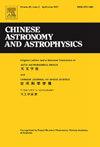Particle-in-cell Simulation of Electromagnetic Field Structure in the Electron-only Reconnection
Q4 Physics and Astronomy
引用次数: 0
Abstract
Standard collisionless magnetic reconnection couples with both electron and ion dynamics. Recently, a new type of magnetic reconnection, electron-only magnetic reconnection without ion outflow, has been observed. Using 2.5D particle-in-cell simulation, the electromagnetic field structure in the electron-only reconnection with a strong guide field was studied. At the moment of the maximum reconnection rate, the electron inflow and outflow are observed on either side of the separatrix. The spatial distribution of the electron bulk velocity is approximately symmetric, which generates the nearly symmetrically distributed Hall current, resulting in the quadrupole Hall magnetic field. The Hall magnetic field is not obviously distorted despite the presence of the strong guide field. Meanwhile, the charge separation is caused in the separatrix region, which generates the nearly symmetrically distributed Hall electric field. Besides, the evolution of the spatial distribution of the electron bulk velocity was studied. The equation of motion for the frozen electrons was analytically obtained: . According to the equation of motion for the electrons, we divide the electron-only reconnection with a strong guide field into two stages. In the first stage, the drift is negligible because of the weaker Hall electric field, and then the electrons flow mainly along the magnetic field line following the equation . In the second stage, the Hall electric field is so strong that the motion of electrons is dominated by the drift following the equation . The simulation shows that extremely strong charge separation can be caused in electron-only reconnection, which generates the nearly symmetrically distributed Hall electric field. With a guide field, this Hall electric field leads to the drift, which dominates the spatial distribution of the electron bulk velocity. Therefore nearly symmetrically distributed Hall current is formed, which generates the nearly symmetrically distributed quadrupole Hall magnetic field.
纯电子重联中电磁场结构的粒子胞内模拟
标准的无碰撞磁重联与电子和离子动力学耦合。近年来,人们发现了一种新型的磁重联,即无离子流出的纯电子磁重联。采用2.5维细胞内粒子模拟方法,研究了强引导场下纯电子重联过程中的电磁场结构。在重联速率最大的时刻,分离矩阵两侧都有电子流入和电子流出。电子体速度的空间分布近似对称,产生近似对称分布的霍尔电流,产生四极霍尔磁场。尽管存在强引导场,霍尔磁场的畸变并不明显。同时,在分离矩阵区域引起电荷分离,产生近似对称分布的霍尔电场。此外,还研究了电子体速度空间分布的演化规律。解析得到冻结电子的运动方程:ve=veyB/By+ exx (byy)/By2。根据电子的运动方程,将强引导场下的纯电子重联分为两个阶段。在第一阶段,由于霍尔电场较弱,E×B漂移可以忽略不计,然后电子主要沿着方程ve≈veyB/By的磁场线流动。在第二阶段,霍尔电场非常强,电子的运动由方程ve≈ex (Byey)/By2的E×B漂移控制。仿真结果表明,在纯电子重联过程中会产生极强的电荷分离,从而产生近似对称分布的霍尔电场。在引导场的作用下,霍尔电场导致E×B漂移,该漂移主导着电子体速度的空间分布。因此形成近似对称分布的霍尔电流,产生近似对称分布的四极霍尔磁场。
本文章由计算机程序翻译,如有差异,请以英文原文为准。
求助全文
约1分钟内获得全文
求助全文
来源期刊

Chinese Astronomy and Astrophysics
Physics and Astronomy-Astronomy and Astrophysics
CiteScore
0.70
自引率
0.00%
发文量
20
期刊介绍:
The vigorous growth of astronomical and astrophysical science in China led to an increase in papers on astrophysics which Acta Astronomica Sinica could no longer absorb. Translations of papers from two new journals the Chinese Journal of Space Science and Acta Astrophysica Sinica are added to the translation of Acta Astronomica Sinica to form the new journal Chinese Astronomy and Astrophysics. Chinese Astronomy and Astrophysics brings English translations of notable articles to astronomers and astrophysicists outside China.
 求助内容:
求助内容: 应助结果提醒方式:
应助结果提醒方式:


